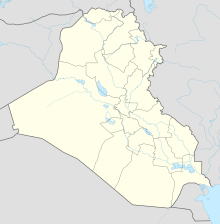Project Babylon
The Babylon project , also called Project 839 , was the construction of super cannons for Iraq by the Canadian engineer Gerald Bull . The project began in March 1988, still during the First Gulf War , and ended with the destruction of the super cannons in November 1991 under the supervision of UN inspectors.
Beginnings
To finance his research, Gerald Bull accepted the contract to develop five super cannons for Iraq under Saddam Hussein , similar to the earlier German V3 cannon. You should be able to reach Israel . Project 839 envisaged the construction of the following cannons:
- two cannons with a caliber of 1000 mm
- two cannons with a caliber of 350 mm and a tube length of 30 meters as well
- a cannon with a caliber of 350 mm and a barrel length of 52.5 meters.
1000 mm caliber
The pipe system should be made up of 26 sections, each 5 to 6 m long and have a maximum length of 150 m. The components were ordered by the Iraqi Oil Equipment Company , manufactured by 13 European companies and some were supplied before the British Secret Intelligence Service prevented further deliveries in 1990. A cannon, mounted horizontally, was to be set up for test trials in the area around Jerf Al-Sakhar and later, if the tests were successful, set up at a 45 degree angle near Jabal Sinjar . The maximum range should be 760 km. The final assembly was never completed as important parts did not reach Iraq; likewise there was no projectile for the super cannon.
Caliber 350 mm
Iraq tried relatively early to advance the development of the 350mm cannon after the 1000mm cannon failed to meet expectations. The 30 m version consisted of three sections of 10 m pipe length each, the 52.5 m version of five sections, the last section being 12.5 m. Only the 52.5 m version has ever been fully assembled and tested; first, to a railway - carriage as rail guns , later in the 45-degree angle at Sinjar Mountains and Dschabal Hamrin. The 52.5 m version was designed (due to the system) for a maximum range of 491 kilometers and a maximum muzzle velocity of 2,510 m / s , the shorter 30 m version for a range of 270 kilometers and a muzzle velocity of 1,937 m / s. The projectiles made of aluminum weighed 67 kg (with a payload of 15 kg), the propellant charges used up to 277.2 kg.
wish and reality
According to a statement by Iraqi General Hussein Kamel , the weapon was supposed to be used to cripple enemy satellites:
“It was meant for long-range attack and also to blind spy satellites. Our scientists were seriously working on that. It was designed to explode a shell in space that would have sprayed a sticky material on the satellite and blinded it. "
“It was designed for long-range attacks and to dazzle spy satellites. Our scientists actually worked on it. It was designed so that a grenade should explode in space and spray an adhesive material on the satellite to blind it. "
“Dictator Saddam Hussein has monster guns built that can shoot satellites into space, but also chemical or nuclear warheads all over the Middle East. [...] With the super cannon, Saddam Hussein wants to obtain a weapon that is simpler, cheaper and also more accurate than anything his rocket engineers have managed to date. "
In fact, in shooting attempts from June 3 to September 24, 1990 at Jebel Hamrin with the 52.5 m cannon, a maximum range of 229 km and a maximum altitude of 62 km were achieved. The target accuracy should be 500 meters; Iraq invested a total of $ 28.6 million in development. In its final report, UNMOVIC was able to completely rule out the use of super cannons for firing weapons of mass destruction (atomic, biological, chemical).
Media utilization
- In the 1994 film Doomsday Gun , the story of the super cannon is the theme.
- The Babylon project forms the background to Frederick Forsyth's thriller “ The Fist of God ”.
Remarks
- ↑ Sheffield Forgemasters produced the steel pipes, Somers in Birmingham built hydraulic shock absorbers and aiming devices, the ammunition and explosives company Astra-Holding let its Belgian subsidiary Poudreries réunies de Belgique (PRB) mix the special propellant charge. The propellant charges were delivered to Iraq disguised as chocolate confectionery. → See: zeit.de Iraqi super cannon .
- ↑ The first cosmic speed for a circular orbit around the earth is 7.9 km / s. Even the maximum design of the super cannon corresponded to just under 30 percent of the necessary speed.
- ^ Pipes, propellant charges and fee for Gerald Bull.
Web links
- fas.org Image of the 52.5 m cannon from the mouth
Individual evidence
- ↑ a b c d e f g UNMOVIC : Chapter IV, Missile Program (PDF; 39.7 MB)
- ↑ Saddam Files (II): The Most Dangerous Man in the World . In: Der Spiegel . No. 6 , 2003 ( online ).
- ↑ James Glanz: Shades of Supergun Evoke Hussein's Thirst for Arms ( English ) nytimes.com . September 10, 2006. Retrieved January 1, 2011.
- ↑ cnn.com Interview with Hussein Kamel, September 21, 1995
- ↑ imdb.de


